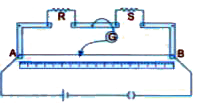LONG ANSWER QUESTIONS - I from U-LIKE PHYSICS (HINGLISH) CURRENT ELECTRICITY for Class 12
| Class 12 | PHYSICS |
| Chapter | CURRENT ELECTRICITY |
| U-LIKE PHYSICS (HINGLISH) | LONG ANSWER QUESTIONS - I |
| Medium | English |
| Academic Year | 2023-2024 |
Question 6
Define the terms (i) drift velocity, (ii) relaxation time. A conductor of length L is connected to a d.c. source of emf ε . If this conductor is replaced by another conductor of same material and same area of cross-section but of length 3L, how will the drift velocity change ? View SolutionQuestion 10
(a) Deduce the relation between current I flowing through a conductor and drift velocity →vd of the electrons.
(b) Figure shows a plot of current I flowing through the cross section of a wire versus the time t. Use the plot to find the charge flowing in 10 s through the wire.
 View Solution
View SolutionQuestion 11
(a) Define the term conductivity of a metallic wire. Write its SI unit.
(b) Using the concept of free electrons in a conductor, derive the expression for the conductivity of a wire in terms of number density and relaxation time. Hence obtain the relation between current density and the applied electric field E. View SolutionQuestion 12
A cell of emf ε and internal resistance 'r' is connected across a variable load resistor 'R'. Draw the plots of the terminal voltage 'V' versus (i) R and (ii) the current I.
It is found that when R = 4 Ω , the current is 1 A and when R is increased to 9 Ω , the current reduces to 0.5 A. Find the values of the emf ε and internal resistance r. View SolutionQuestion 13
A number of identical cells, n, each of emf ε , internal resistance r connected in series are charged by a d.c. source of emf ε , using a resistor R.
(i) Draw the circuit arrangement.
(ii) Deduce the expressions for (a) the charging current and (b) the potential difference across the combination of the cells. View SolutionQuestion 14
Two cells of emf ε1 and ε2 having internal resistances r1 and r2 respectively are connected in parallel as shown in Fig. Deduce the expressions for the equivalent emf and equivalent internal resistance of a cell which can replace the combination between the pointsB1 and B2 .
 View Solution
View SolutionQuestion 15
(a) The potential difference applied across a given resistor is altered so that the heat produced per second increases by a factor us 9. By what factor docs the applied potential difference change?
(b) In the figure shown, an ammeter A and a resistor of 4Ω are connected to the terminals of the source. The emf of the source is 12 V having an internal resistance of 2Ω . Calculate the voltmeter and ammeter readings.
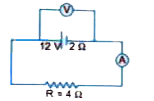 View Solution
View SolutionQuestion 16
The temperature coefficient of resistivity for two materials A and B are 0.0031/∘C , and 0.0068/∘C respectively. Two resistors R1 and R2, made from material A and B respectively, have resistances of 200 Ω and 100 Ω at 0∘C . Show the colour code of a carbon resistor that would have a resistance equal to the series combination of R1 and R2 at a temperature of 100∘C (Neglect the ring corresponding to the tolerance of the carbon resistor). View SolutionQuestion 23
A student uses the circuit diagram of a potentiometer as shown in Fig.
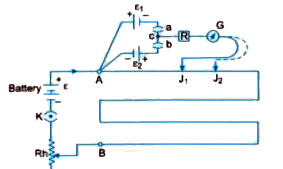
(a) For a steady current I passing through the potentiometer wire, he gets a null point for the cell ε1and not for ε2 . Give reason for this observation and suggest how this difficulty can be resolved.
(b) What is the function of resistance R used in the circuit? How will the change in its value affect the null point ?
(c ) How can the sensitivity of the potentiometer be increased? View SolutionQuestion 24
(i) State the principle of working of a metre bridge.
(ii) In a metre bridge balance point is found at a distance l1 with resistances R and S as shown in the figure.
When an unknown resistance X is connected in parallel with the resistance S, the balance point shifts to a distance l. Find the expression for X in terms of l1,l2 and S.
 View Solution
View SolutionQuestion 26
The Fig. shows experimental set up of a metre bridge. When the two unknown resistances X and Yare inserted, the null point Dis obtained 40 cm from the end A. When a resistance of 10Ω is connected in series with X, the null point shifts by 10 cm. Find the position of the null point when the 10Ω resistance is instead | А connected in series with resistance ‘Y. Determine the values of the resistances X and Y.
 View Solution
View SolutionQuestion 29
For the potentiometer circuit shown in the given figure, points X and Y represent the two terminals of an unknown emf ε . A student observed that when the jockey is moved from the end A to the end B of the potentiometer wire, the direction of the deflection in the galvanometer remains in the same direction. What may be the two possible faults in the circuit that could result in this observations ? If the galvanometer deflection at the end B is (i) more, (ii) less, than that at the end A which of the two faults," listed above, would be there in the circuit ? Give reasons in support of your answer in each case.
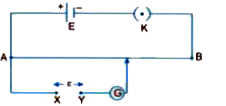 View Solution
View SolutionQuestion 30
(a) For the circuit shown in the figure, how would the balancing length be affected, if (i) R1 is decreased, (ii) R2 is increased, the other factors remaining the same in the circuit ? Justify your answer in each case.
(b) Why is a potentiometer preferred over a voltmeter ? Give reason.
 View Solution
View SolutionQuestion 31
Two cells of emf 1.5 V and 2 V and internal resistance 1Ω and 2Ω respectively are connected in parallel to pass a current in the same direction through an external resistance of 5Ω.
(i) Draw the circuit diagram.
(ii) Using Kirchhoff's laws, calculate the current through each branch of the circuit and potential difference across the 5Ω resistor. View SolutionQuestion 41
Two heating elements of resistances R1 and R2 when operated at a constant supply of voltage, V, consume powers P1 and P2 respectively. Deduce the expressions for the power of their combination when they are, in turn, connected in (i) series and (ii) parallel across the same voltage supply. View SolutionQuestion 42
A potentiometer wire of length 1 m is connected to a driver cell of emf 3 V as shown in the Fig. When a cell of 1.5 V emf is used in the secondary circuit, the balance point is found to be 60 cm. On replacing this cell and using a cell of unknown emf, the balance point shifts to 80 cm.
(i) Calculate unknown emf of the cell.
(ii) Explain with reason, whether the circuit works, if the driver cell is replaced with a cell of emf 1V.
(iii) Does the high resistance R, used in the secondary circuit affect the balance point? Justify your answer.
 View Solution
View SolutionQuestion 43
A 10 m long wire of uniform cross-section and 20Ω resistance is used in a potentiometer. The wire is connected in series with a battery of 5 V along with an external resistance of 480 2. If an unknown emf E is balanced at 6.0 m length of the wire, calculate (i) the potential gradient of the potentiometer wire, (ii) the value of unknown emf. View SolutionQuestion 44
A circuit using a potentiometer and battery of negligible internal resistance is set up as shown in Fig. to develop a constant potential gradient along the wire AB. Two cells of emfs ε1 and ε2 are connected in series as shown in combinations (1) and (2). The balance points are obtained respectively at 400 cm and 240 cm from the point A. Find (i) ε1ε2 , (ii) balancing length for the cell ε1 only .
 View Solution
View SolutionQuestion 45
In the Fig., a long uniform potentiometer wire AB is having a constant potential gradient along its length. The null points for the two primary cells of emf ε1 and ε2 connected in the manner shown are obtained at a distance of 120 cm and 300 cm from the end A. Find (i)ε1/ε2 and (ii) position of null point for the cell ε1. How is the sensitivity of a potentiometer increased ?
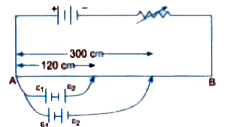 View Solution
View Solution
All Exercises from U-LIKE PHYSICS (HINGLISH) Class 12 PHYSICS CURRENT ELECTRICITY
- NCERT TEXTBOOK EXERCISES
- ADDITIONAL EXERCISES
- CASE BASED/SOURCE-BASED INTEGRATED QUESTIONS
- MULTIPLE CHOICE QUESTIONS
- FILL IN THE BLANKS
- TRUE OR FALSE
- ASSERTION-REASON TYPE QUESTIONS
- VERY SHORT ANSWER QUESTIONS
- SHORT ANSWER QUESTIONS
- LONG ANSWER QUESTIONS - I
- LONG ANSWER QUESTIONS - II
- SELF ASSESSMENT TEST (SECTION A (FILL IN THE BLANKS))
- SELF ASSESSMENT TEST (SECTION A (MULTIPLE CHOICE QUESTIONS))
- SELF ASSESSMENT TEST (SECTION A (VERY SHORT ANSWER QUESTIONS ))
- SELF ASSESSMENT TEST (SECTION B )
- SELF ASSESSMENT TEST (SECTION C )



